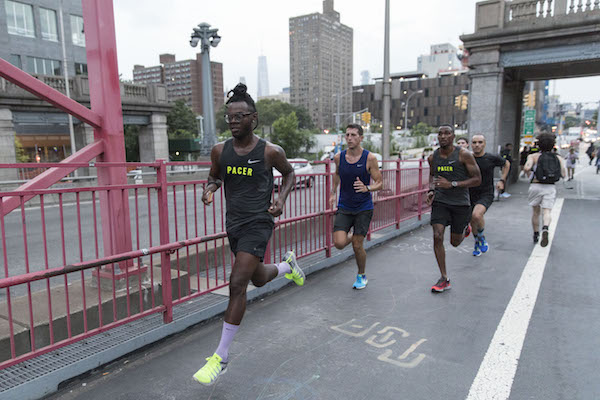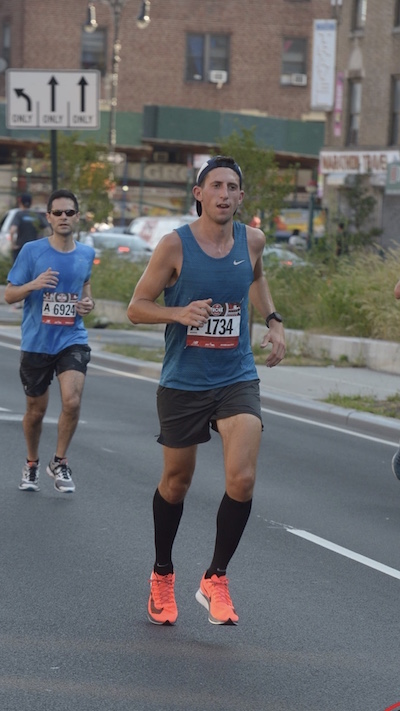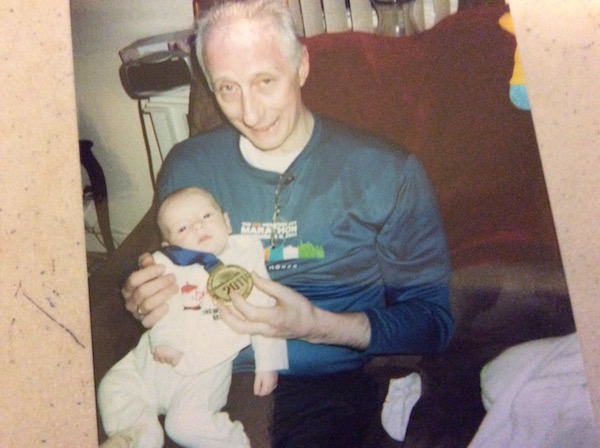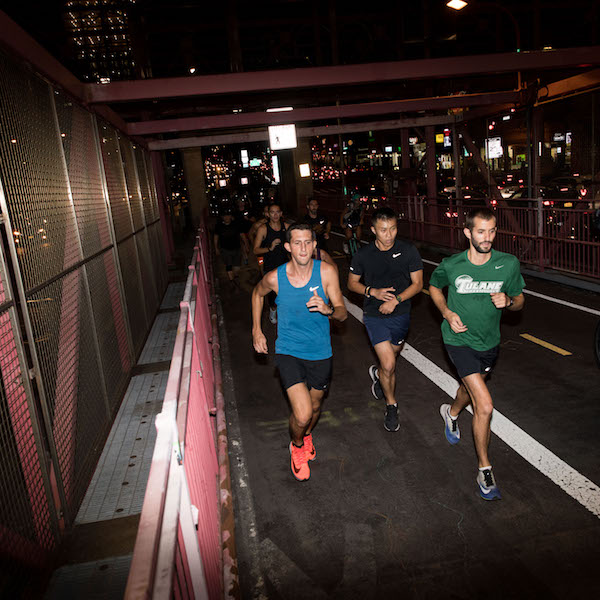
BY SCOTT STIFFLER | Their challenge is the same — but for Gene Byrne, 63, of Hell’s Kitchen and Andrew Leibowitz, 27, of Chelsea, the path they’ve traveled on the road to this weekend’s TCS New York City Marathon is as distinct as the neighborhoods they call home.
“I look at myself as a clarion call for all the people in their 60s, 70s, and 80s to keep competing,” said self-described “West Side Irish kid” Byrne, who, despite quadruple bypass surgery and two hip replacements along the way, is anticipating his 16th consecutive fall trek through the five boroughs. “If you’re a runner,” Byrne declared, “you’re always going to be doing it, in some way, because it’s just part of your makeup.” For Leibowitz, crossing the finish line in Central Park will be cause for multiple celebrations — his first marathon, his 28th birthday, and a reminder of how far he’s come. “Six years ago,” he recalled, “I weighed almost north of 250 pounds.”
When Chelsea Now recently spoke with both men as they prepared for Nov. 5’s rain or shine, hot or cold event, each had a unique perspective on how they achieved the athleticism and mental fortitude necessary to take on the grueling 26.2-mile course.
A Day of Milestones for Andrew Leibowitz
“The furthest I’ve ever run is 22 miles,” said Andrew Leibowitz, who will have to go that distance and 4.2 more over the course of his first NYC Marathon. In preparation, he told us, “The mental aspect of training is just as important as the physical. You can only really do what your mind believes you can do. It’s about keeping your eyes on the finish, but also the start line; not doing anything foolish, like overtraining or not listening to your body. So you create this training plan 16, 18 weeks out.”

On the day we spoke with him — Oct. 12 — Leibowitz had just ran his 10th half marathon. The Staten Island Half, he said, was “pretty tough. It was either absolutely pouring or it was hot, but never at the same time.” Still, he noted, the experience “has me feeling pretty good about the full marathon.”
More than just the challenge of completing the course, Leibowitz says the Nov. 5 event “is, in reality, a celebration of losing over 100 pounds. The marathon is a huge time suck, to carve out all of those miles; and it’s something you have to stay very dedicated to. But it’s a celebration of what I can do now because I’m so far from where I was then.”
Having taken up running as part of a sea change in attitude and behavioral habits, Leibowitz said, “I am no longer within that range where I have to be concerned about my long-term health. I wake up in the morning and I’m more confident, more relaxed. It was always in the back of my head, worrying about someone noticing how much I weighed. Now, it’s about knowing I’m putting myself in the best possible situation to have the life I want to have… but once you lose that weight, that struggle doesn’t end. You have to be dedicated.” Within that quest to maintain a healthy weight and lifestyle, Leibowitz noted stress triggers or temptations “can be responded to by either going for some ice cream or making a better choice. So I’m a big fan of almond butter, usually with a piece of whole grain toast and a banana. That’s one of my favorite snacks.”
Running primarily solo but sometimes with others, Leibowitz will log up to 60 miles in a single week, which takes him “all over Manhattan. The easier runs typically start around the Chelsea Piers area, up through Pier 88.” Twice a week, there are “more intensive efforts I do with a group of people; interval training or longer distances at faster paces. This Tuesday [Oct. 10], I did a 7-mile progression run, starting at a marathon pace [6:50 to 7:00 minutes per mile] and then a 10K pace [about 6:00]. Sundays are long runs, as short as 16 miles and up to 22.”
When we spoke with him, Leibowitz was planning to train that night with Nike’s “Project Moonshot” group, an offshoot, he explained, of the “Breaking2” project, which sought to break the 2-hour marathon record.
“They took three star marathoners,” Leibowitz said, “and fell short, but still managed the best in recorded history. So they’re taking some of the things they learned in that project and applying it to some runners in the New York City Marathon; nutrition, cross training, physical therapy, and ‘pre-habilitation’ — keeping your body fit upfront instead of fixing things before they break. They had an application process early this year, so they could help these runners make their own goals. My time goal is 3 hours and 5 minutes, the Boston Marathon qualification time,” said Leibowitz, who equates Boston “to the Super Bowl for the amateur runner. You can do it for charity or time qualify, and it’s a pretty small field compared to other city marathons. Very competitive to get into.”
Since qualification for Beantown at this point means a 2019 run at the earliest (next year’s field is already booked, he noted), we asked Leibowitz what his lifestyle routine might resemble after accomplishing his NYC Marathon goal. “It’s almost as if I am now on the other side of that grind, and I am thinking, ‘How do we keep it healthy?’ I feel great where I am, but I don’t need a six-pack. After the marathon, at least short-term the goal is to cut back on the running to that range I was in beforehand. The number in itself,” he said, referencing pounds on the body as much as miles on the road, “is not as important to me as it was — so long as I am healthy and fit.”
For Gene Byrne, “She’s the Reason”
Raised on W. 83rd and Amsterdam Ave., Gene Byrne spent a decade in Richmond County working for Bill Murphy as an assistant district attorney. Then, he recalled, “When I decided to move back into Manhattan [in 1997], Hell’s Kitchen was an ‘up and coming neighborhood’ even 20 years ago.” For the past 17 years, Byrne has been a criminal defense attorney. Always athletic (“I played rugby for the New York Athletic Club for about nine seasons”), Byrne ran his first marathon in 1998 when he “got a phone call from a buddy who was going to do the Rock ‘n’ Roll San Diego Marathon” and convinced him to make the trip to the West Coast. At the time, he noted, “I had never ran more than eight miles.” He had under a month to prepare.
On a morning where the starting temp was 92 degrees, Byrne ended up completing the race in 4 hours, 2 minutes and 53 seconds. “No one told me about four hours as being the mark of a legitimate runner,” he recalled. “So I thought, ‘let me take a shot at New York. It’s the hometown race. It’s a home game.’ I started training for that, and in 1998 I ran it in 3 hours, 48 minutes.”
During a return to San Diego’s marathon the following year, he hoped to complete the course in 3 ½ hours, which would have qualified him for the Boston Marathon. But on the day of the race he wasn’t feeling well and ran almost 20 minutes past that time. “After that,” Byrne said, “I don’t know what happened. In January of 2000, I was out for a tempo run [a “comfortably hard” pace, according to runnersworld.com] in Central Park and it felt like my elbow was going to explode. I don’t even remember walking out of the park.” His girlfriend at the time, a nurse, convinced him to go seek immediate medical help. “A quadruple bypass later,” Byrne said, “I remember telling myself when I was in the hospital, ‘I’m going to run 15 New York Marathons in a row to come back from this.’ ”

For Byrne, learning about his time bomb ticker came as a surprise — with an explanation provided by his bypass surgeon (Dr. Henry Greenberg, he told us, the name rolling off his tongue in a manner not uncommon among those who’ve bonded with the person responsible for opening their chest and stopping their heart).
“Because I was an athlete,” Byrne noted, “Dr. Greenberg said, ‘You’re so fit, doctors don’t usually check guys like you for certain things. You fell through the cracks.’ ” Shortly after the surgery, “Greenberg told me he saw the frustration of an ex-athlete no longer able to operate at the level he was used to. He told me, ‘Your heart is a muscle. The more you work it, the stronger it gets.’ I said, ‘Doctor, I got plans.’ ”
Byrne has since made very good on that declaration by successfully completing every NYC Marathon since 2002 (he also conquered IRONMAN triathlons in 2007 and 2008). But his days of running are over. “I walked last year’s marathon,” he said, “because I had my left hip replaced in 2016.” This past July, Byrne underwent the same procedure for his right side. “The days of running are pretty much over,” he said, “but that doesn’t mean you walk away. What’s important is not finishing in the top five. It’s knowing you did your best.”
Determined to complete his 16th NYC Marathon, Byrne’s cardio training routine includes swimming and spinning, along with loops around Central Park — motivated by a desire for health and longevity to set an example, and be around, for his six-year-old daughter, Kellsey Oceane Byrne. “She’s the reason,” he noted, referencing much more than a marathon.

































